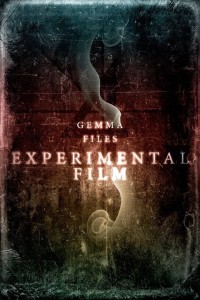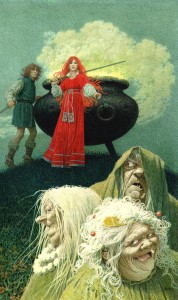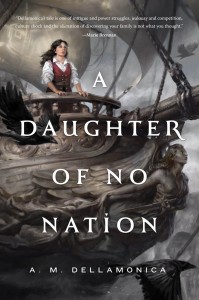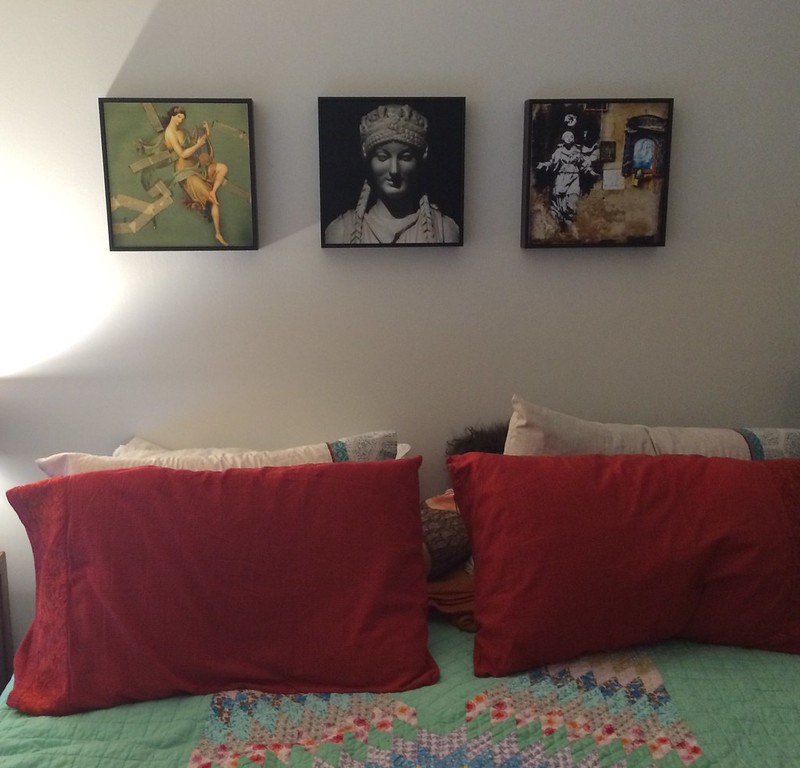 Former film critic and teacher turned award-winning horror author Gemma Files is probably best known for her Hexslinger series (A Book of Tongues, A Rope of Thorns and A Tree of Bones, all from ChiZine Publications). She has also published two collections of short fiction (Kissing Carrion and The Worm in Every Heart), two chapbooks of poetry and a story cycle (We Will All Go Down Together: Stories of the Five-Family Coven). Her story “The Emperor’s Old Bones” won the International Horror Guild’s 1999 Best Short Fiction award. She’s since been nominated twice for the Shirley Jackson award, and won the Black Quill Award for her first novel.
Former film critic and teacher turned award-winning horror author Gemma Files is probably best known for her Hexslinger series (A Book of Tongues, A Rope of Thorns and A Tree of Bones, all from ChiZine Publications). She has also published two collections of short fiction (Kissing Carrion and The Worm in Every Heart), two chapbooks of poetry and a story cycle (We Will All Go Down Together: Stories of the Five-Family Coven). Her story “The Emperor’s Old Bones” won the International Horror Guild’s 1999 Best Short Fiction award. She’s since been nominated twice for the Shirley Jackson award, and won the Black Quill Award for her first novel.
I am insanely excited about Gemma’s next book Experimental Film, because like her horrifying, creepy, delightful, gut-wrenching Apex story “each thing i show you is a piece of my death” (co-written with Stephen J. Barringer) it’s about a haunted film.
I started with the question I’ve been asking my other interviewees. Is there a literary heroine on whom you imprinted as a child? A first love, a person you wanted to become as an adult, a heroic girl or woman you pretended to be on the playground at recess? Who was she?
You know, I wish this was an easy question to answer, because it’s not, and that’s pretty sad. I mean…I started out with C.S. Lewis’s Chronicles of Narnia, the first books I can remember re-reading for pleasure, and while there are some sort of contextually wonderful female characters in that, they often undergo a transition which leaves them in a far less great place by the end of their overall narratives.
Lucy Pevensie grows up in Narnia, for example, becomes a queen, then gets busted back down into a child “in real life,” and remains one every time she returns; Aravis Tarkheena from The Horse and His Boy learns a lesson about why her original culture sucks, then marries into and adopts another, “better” one; Jill Pole and Polly Plummer have interesting adventures in their respective youths, then literally end up dead and in Heaven post-apocalypse, along with Lucy—and the less said about Susan, as many have noted, the better.
So weirdly, the female character I imprinted on most strongly was Jadis of Charn, introduced in The Magician’s Nephew, who becomes The Lion, the Witch and the Wardrobe’s White Witch, and in hindsight that may be because while her personal journey takes her straight to hell, she at least drives it every step of the way herself. Just as the city-state of Charn itself crossbreeds Ancient Egypt, Rome, Byzantium, Babylon and Ur, Jadis is both a relic and the end-product of a far older, darker, more barbaric/decadent civilization, literally enormous (half jinn and half giant), highly-coloured and full of destructive energy, especially when juxtaposed with dull, rainy, “realistic” turn-of-the-20th-century England. She’s framed as a hybrid of Eve and Lucifer, scarfing down a magic apple and sacrificing what remains of her soul for knowledge and power—but then again, that decision makes total sense, considering that even in her imperious yet rudely innocent earlier form, she’s still the kind of person who boasts about using the atomic bomb-like Deplorable Word to exterminate every other person in her pocket dimension just to make sure her sister can never take the throne from her. When we first meet her Jadis is an evil Sleeping Beauty, undisputed empress of a dead planet, but she gets worse, and that’s her choice; she’s truly awesome, in the oldest sense of the word.
Looking back, however, I realize that what I’m skipping over in my brain is the fact that even then I was fascinated with archaeology and history, which means that my real first book of “female characters” might actually have been a coloring book called Notorious Women, the women in question running the gamut from Semiramis, Hatshepsut, Artemisia and Agrippina the Younger to Irene Basileus, Wu Zetian, Roxelana (also known as Hurrem Sultane), Lucrezia Borgia and Queen Mary Tudor. These were women who seized power by any means they deemed necessary and did whatever they felt they had to in order to keep it as long as possible, employing everything from poison, murder, sex and religious persecution to outright witchcraft in their struggle for dominance, while also dressing extremely well. Jadis had a lot in common with these ladies, so in a strange way, I think she felt more innately “realistic” to me than any of Lewis’s nicer, more Aslan-approved girls.
This attraction towards evil queens, witches, worshippers of dark forces and villains who didn’t think of themselves as such extended into the subsidiary influences of Arha/Tenar from Ursula K. LeGuin’s The Tombs of Atuan, Achren from Lloyd Alexander’s Chronicles of Prydain, and Linda from Ruth Nichols’ The Marrow of the World, all of whom are singular, ill-fated and doubtful of their own capacity for goodness. Tenar is, I suppose, the most overtly heroic of the bunch, especially in the later books I wouldn’t read until I was in my forties, written when LeGuin started to intentionally dismantle the sexist undercurrents of Earthsea’s patriarchal motto “weak as women’s magic, wicked as women’s magic”—but there’s a fight I remember in Marrow which has always stayed with me, especially so when Trina Schart Hyman’s illustration is added in on top: Linda squaring off against a demon that’s made itself look like a little girl, putting herself deliberately between it and two defenceless humans—one her long-forgotten half-brother, the other her “cousin” from our world, where her witch-mother sent her into exile—who both cheer her on, all the while wondering inside who’s the bigger threat in the fight.
So Jadis, obviously, had qualities that captured your affections and your imagination?
Well, I guess I’ve basically always seen myself as a monster: too loud, too angry, too physically overdeveloped and full of useless information, never comfortable, never liked. I looked at books like Harriet The Spy and thought: “Oh hey, she has glasses too, she makes up stories…” But then by the story’s climax I both despised Harriet and envied her, despised her because she got caught and punished and accepted the judgement of her peers, envied her because she was rewarded with genuine friendship and support at the end of her shaming. I felt a similar ambivalence towards April, the protagonist of Zilpha Keatley Snyder’s The Egypt Game, who had a glamourous but absent actress mother, who dressed up and told eccentric, gigantic lies about herself that never quite came off, yet managed to attract a set of likeminded co-conspirators after her out-of-control imagination intersected with that of Melanie, the girl downstairs.
I didn’t fantasize about either of them, though, because doing so felt ridiculous; I already knew what it was like to be larger-than-life in a tiny world, trapped by standards for social normalcy I knew I’d never be able to conform to, constantly policed by other people whose opinions I didn’t care about. No, it was much more interesting to think about blood and gold and human sacrifice, giant evil gods, shapeshifters, dynastic intermarriage, spasms of war and rape and murder—archaeology crossed with mythology, fairytales from one end of the globe to the other, the D’Aullaires’ books of Greek and Norse gods, Barbara Nynde Byfield’s Book of Weird and Georgess MacHarque’s The Impossible People. I wanted beauty and strangeness and danger, always danger. And I had no recourse to anything but my own badly-organized dreams along those lines, until I finally tripped across Tanith Lee.
I remember starting to go into second-hand bookstores when I was twelve and thirteen and buying up huge wads of DAW Fantasy, with that emblematic yellow spine. Lee’s stuff was always the best of the bunch, and though sometimes—often, actually—it didn’t end up going exactly where I wanted it to, I was always fascinated by where it did, especially in her Tales from the Flat Earth series. Again, the debatably evil goddess-witch queens (Oaive from The Winter Players, Zorayas daughter of Zorashad, Narasen of Merh, Azhriaz) were right at the forefront of my interests, but Lee soon added in a layer of sexually-ambiguous/borderline inhuman dudes on top: Cyrion, Deketon from East of Midnight, Azhrarn, Zhirem/Zhirek and Shell/Simmu. C.J. Cherryh was pretty good here and there, along with Elizabeth A. Lynn, but with Lee it was like she was channelling her stuff straight from id to the page.
How does these influences compare to the female characters in your work? Are they their literary ancestors? Do they rebel against all she stands for? What might your heroines owe her?
Definitely, the trend of terrible people coming to grips with their own terribleness is a backbone of my work, as is the general theme of monstrosity, particularly of the feminine variety; if I had to guess, that’s probably most visible thus far throughout my story cycle We Will All Go Down Together: Stories of the Five-Family Coven, which is even structured like one of Lee’s Flat Earth books. But even in the otherwise dick-heavy Hexslinger series, I’ve still tried to consistently make room for characters like Yancey, Songbird, Yiska, Grandma, Oona Pargeter and Ixchel, who hopefully provide a spectrum of female-oriented weirdness. Power, with its rewards and its discontents, remains what I’m most attracted to, and seeing it channelled through a vaguely feminine form? That’s my crack, always was. Always will be.
In a lot of ways, my upcoming novel Experimental Film (out by November, from CZP) combines these formative fantasies and impulses in a story driven by three different female characters. First off, there’s Lois Cairns, the protagonist and narrator who often thinks she’s a monster of the sadly metaphorical RL kind; she’s literally my attempt to write myself-but-not-really and explore various problems from my adult life through fiction, such as the difficulties of balancing personal creativity with being the mother of a child with special needs. Mrs A. Macalla Whitcomb, on the other hand—the long-lost early Ontario filmmaker whose work Lois accidentally discovers—is more of a cautionary tale or a tragic figure, an artist possessed and destroyed by her own vision who comes off like either a witch or a martyr, depending on who you talk to. As for Lady Midday, meanwhile, the creature whose supernatural influence may lurk behind everything Lois experiences during her journey into Mrs Whitcomb’s world—she’s a legend, a myth, a not-so-dead goddess, able to exult, inspire and destroy at a whim. The main difference between her and the all-powerful witch-queens of my youth is that I’m now old enough to know that good and evil aren’t exactly concepts that apply, when you’re talking about something that was never really human.
______
About this post: The Heroine Question is an interview series where female authors answer questions about their artistic influences and fictional heroines. I’m planning to arrange for you all to see answers to these three questions, and variations on them, popping up throughout the summer from a number of terrific authors. Enjoy! (Or, better yet, comment, tweet, and repost!)
 Caitlin Sweet is the author of three adult fantasy novels: A Telling of Stars (Penguin Canada, 2003), The Silences of Home (Penguin Canada, 2005), and The Pattern Scars
Caitlin Sweet is the author of three adult fantasy novels: A Telling of Stars (Penguin Canada, 2003), The Silences of Home (Penguin Canada, 2005), and The Pattern Scars (Chizine Publications, 2011). The Door in the Mountain
(Chizine Publications, 2014) is her first young adult book, and it is on the shortlist for this year’s Sunburst Award, whose jury says:
, will be published in fall 2015. Her first three books were nominated for Locus Best First Novel, Aurora, and Sunburst Awards; The Pattern Scars
won the CBC Bookie Award in the Science Fiction, Fantasy or Speculative Fiction category.





